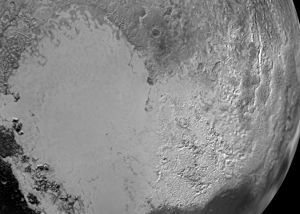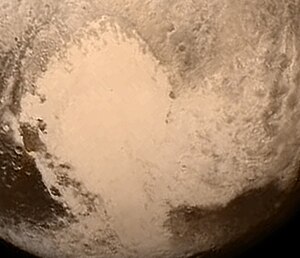Benutzer:Tanneneichhorn/Tombaugh-Region
| Ebene auf ?? | |
|---|---|
| Tanneneichhorn/Tombaugh-Region | |

| |
| Hochauflösendes Mosaik aus monochromen Aufnahmen von New Horizons | |
| Position | Koordinaten fehlen! Hilf mit.Koordinaten fehlen! Hilf mit. |
| Ausdehnung | 1.590 km[1] |
| Geschichte | |
| Datum der Entdeckung | Juli 2015 |
| Benannt nach | Clyde Tombaugh |
Die Tombaugh Regio, nach ihrer Form auch Das Herz genannt[2], ist die größte helle Region auf dem Zwergplaneten Pluto.
Beschreibung
Tombaugh Regio ist eine große, helle Region about Vorlage:Convert across.[1] The two lobes of the feature are geologically distinct. Die westliche Ausbuchtung, Sputnik Planum, is smoother than the eastern, and they are of slightly different colors.[3] Early Spekulation war, dass the western lobe a großer Einschlagkrater sein könnte, filled with Stickstoffschnee. Bright spots within the region were initially speculated to be mountain peaks.[4] Photos, released on 15 July 2015, revealed Vorlage:Convert mountains made of water ice in the feature; sie zeigten auch keine Krater in derselben Region.[5] Subsequent data indicated dass das Zentrum des Sputnik Planum reich an Stickstoff, Kohlenstoffmonoxid, und Methaneis ist, und dass features near the edges of the region show evidence of ice flow such as Gletscher, and light material overlying the darker material at the eastern edge of Cthulhu Regio.[6] The surface of Sputnik Planum is divided into polygonal convection cells[7] and is less than 10 million years old, indicating that Pluto is geologically active.[8]
The feature had been identified as a bright spot for six decades prior to the New Horizons flyby, although it was impossible to image it with enough resolution to determine its shape. Over these six decades the spot had been observed to be dimming.[9]
Namensgebung
Die Tombaugh-Region wurde zuerst identified in the initial image of Pluto returned after the New Horizons probe recovered from an anomaly that temporarily sent it into safe mode. NASA initially referred to it as a "heart" in reference to its overall shape.[10] On 15 July 2015, the region wurde „Tombaugh Regio“ genannt by the New Horizons team in honor of astronomer Clyde Tombaugh, the discoverer of Pluto, regio being Latin for 'region'.[11] The approval of the International Astronomical Union (IAU) is required before the name "Tombaugh Regio" can become official, but Rita Schulz, chair of the IAU's Working Group for Planetary System Nomenclature, has said the group "could approve this name right away, as we have pre-discussed it."[12]
Some people find the feature also resembles the Disney character Pluto, an animated non-anthropomorphic dog which shares the name of the dwarf planet.[13][14][15] The Walt Disney Company acknowledged this perceived likeness in a short animation.[13][16]
Galarie
Vorlage:Gallery Vorlage:Gallery Vorlage:Gallery Vorlage:Gallery Vorlage:Gallery
Siehe auch
Einzelnachweise
References
Vorlage:Pluto [[Category:Surface features of Pluto]] [[Category:Geography of Pluto]]
- ↑ a b Rachel Feltman: New map of Pluto reveals a ‘whale’ and a ‘donut’. The Washington Post. 8 July 2015. Abgerufen im 14 July 2015.
- ↑ New data reveals that Pluto's heart is broken
- ↑ Rachel Feltman: New data reveals that Pluto’s heart is broken. The Washington Post. 14 July 2015. Abgerufen im 14 July 2015.
- ↑ Joel Achenbach: New Horizons reaches Pluto, sees complex terrain with ‘great mounds’. The Washington Post. 14 July 2015. Abgerufen im 14 July 2015.
- ↑ Jessica Orwig: The first insanely close-up photos of Pluto reveal water on its surface. Business Insider. 15 July 2015. Abgerufen im 15 July 2015.
- ↑ New Horizons Discovers Flowing Ices on Pluto. NASA. Abgerufen im 25 July 2015.
- ↑ Emily Lakdawalla: Pluto updates from AGU and DPS: Pretty pictures from a confusing world. The Planetary Society. 21. Dezember 2015. Abgerufen am 24. Januar 2016.
- ↑ F. Marchis, D. E. Trilling: The Surface Age of Sputnik Planum, Pluto, Must Be Less than 10 Million Years. In: PLOS ONE. 11, Nr. 1, 20. Januar 2016, S. e0147386. arxiv:1601.02833. bibcode:2016PLoSO..1147386T. doi:10.1371/journal.pone.0147386.
- ↑ Christopher Crockett: Mission to Pluto: Live coverage: Sitting and speculating. Science News. 14 July 2015. Abgerufen im 15 July 2015.
- ↑ NASA’s New Horizons: A “Heart” from Pluto as Flyby Begins. NASA. 8 July 2015. Abgerufen im 15 July 2015.
- ↑ Kelly Beatty: Pluto and Charon Dazzle with Diversity. Popular Mechanics. 2015. Abgerufen im 16 July 2015.
- ↑ Alan Boyle: Pluto, we have a problem: Some geographical names may not fly on official maps. GeekWire. 25 August 2015. Abgerufen im 14 September 2015.
- ↑ a b Mike Westfall: Does Pluto's bright spot look more like a heart or the Disney dog?. Bay News 9. 14 July 2015. Abgerufen im 16 July 2015.
- ↑ Alyssa Newcomb: New Horizons Space Probe: Pluto Gets the Meme Treatment. ABC News. 14 July 2015. Abgerufen im 16 July 2015.
- ↑ The best Pluto memes. Well done, internet. BBC. 15 July 2015. Abgerufen im 16 July 2015.
- ↑ Vorlage:Cite tweet
